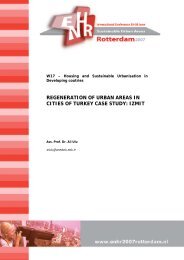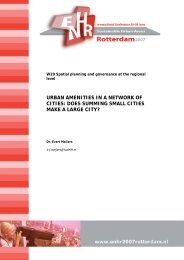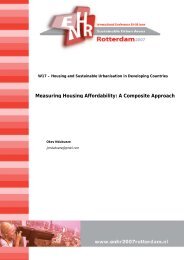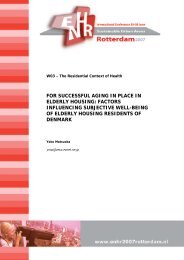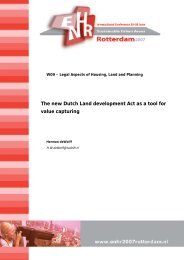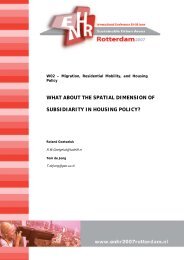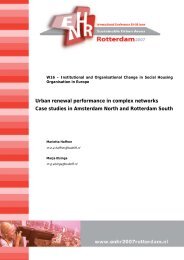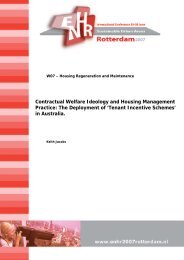cultural and spatial dynamics of istanbul: new housing trends
cultural and spatial dynamics of istanbul: new housing trends
cultural and spatial dynamics of istanbul: new housing trends
You also want an ePaper? Increase the reach of your titles
YUMPU automatically turns print PDFs into web optimized ePapers that Google loves.
W08 – Residential Environments <strong>and</strong> People<br />
CULTURAL AND SPATIAL DYNAMICS OF<br />
ISTANBUL: NEW HOUSING TRENDS<br />
Hulya Turgut Yildiz<br />
turguthl@itu.edu.tr<br />
Goksenin Inalhan<br />
inalhang@itu.edu.tr
Cultural <strong>and</strong> Spatial Dynamics <strong>of</strong> Istanbul: New Housing Trends<br />
ENHR 2007 International Conference ‘Sustainable Urban Areas’<br />
Cultural <strong>and</strong> Spatial Dynamics <strong>of</strong> Istanbul: New Housing Trends<br />
Workshop: name <strong>of</strong> workshop<br />
Author: name <strong>of</strong> author<br />
Hulya Turgut Yildiz<br />
Department <strong>of</strong> Architecture<br />
Istanbul Technical University, space@itu.edu.tr, turguth1@itu.edu.tr.<br />
fax:+90212 244 92 43<br />
Goksenin Inalhan<br />
Department <strong>of</strong> Architecture<br />
Istanbul Technical University, inalhang@itu.edu.tr<br />
fax:+90212 244 92 43<br />
Keywords: city <strong>dynamics</strong>; urban <strong>housing</strong>; change; continuity; <strong>spatial</strong> transformations; gated<br />
communities<br />
Abstract<br />
The twentieth century is marked as the century <strong>of</strong> urban transition. Cities throughout the world have<br />
experienced fundamental social, <strong>cultural</strong> <strong>and</strong> economic transformation in recent decades. Socio-<strong>cultural</strong><br />
<strong>and</strong> urban identities have been transforming radically; globalization, internationalization <strong>and</strong> the rapid flow<br />
<strong>of</strong> information, as the case in the rest <strong>of</strong> the world, have played a significant role in changing cities <strong>and</strong><br />
their people.<br />
These changing <strong>dynamics</strong> have affected continuity <strong>and</strong> development <strong>trends</strong> in urban-<strong>housing</strong><br />
environments <strong>and</strong> <strong>housing</strong> preferences. The multidimensional outcomes <strong>of</strong> this transformation are<br />
manifest in peculiarities <strong>of</strong> activity patterns, behavioral relationships, <strong>and</strong> socio-<strong>cultural</strong> norms, as well<br />
as in architectural <strong>and</strong> urban configurations. These rapid economic <strong>and</strong> social changes dem<strong>and</strong><br />
continual redefinition <strong>of</strong> urbanization <strong>and</strong> <strong>housing</strong> concerns. Therefore the main aim <strong>of</strong> the paper that<br />
based on ongoing research is to examine the <strong>trends</strong> <strong>and</strong> implications <strong>of</strong> architectural transformations in<br />
Istanbul with the subjects <strong>of</strong> economical, <strong>cultural</strong> <strong>and</strong> political conditions.<br />
Based on these above arguments, in the paper, in order to accomplish the objectives set, a conceptual<br />
overview on urban <strong>and</strong> <strong>housing</strong> transformation <strong>and</strong> a literature survey <strong>of</strong> the latest <strong>housing</strong> <strong>trends</strong> in<br />
Istanbul is analyzed. To discuss these emerging patterns <strong>of</strong> social <strong>and</strong> <strong>cultural</strong> differentiation in<br />
Istanbul since 1980, a number <strong>of</strong> <strong>new</strong> <strong>housing</strong> settlements are chosen as a case for their being good<br />
examples <strong>of</strong> a residential site <strong>of</strong> duality, fragmentations <strong>and</strong> polarity. This study by reviewing aspects<br />
<strong>of</strong> architectural transformations, highlighting <strong>cultural</strong> <strong>and</strong> <strong>spatial</strong> <strong>dynamics</strong> <strong>of</strong> the city provides<br />
valuable information regarding the development <strong>of</strong> base criteria for decision making process. The<br />
decision makers such as, municipalities, planners <strong>and</strong> other related organizations would highly benefit<br />
from the findings <strong>of</strong> this study in their decision making processes for the development <strong>of</strong> the city.<br />
1
Cultural <strong>and</strong> Spatial Dynamics <strong>of</strong> Istanbul: New Housing Trends<br />
Introduction<br />
Since world is in a state <strong>of</strong> flux, nowadays urban environments become the most important thing in the<br />
reflections <strong>of</strong> these changes. Each period, has sharpened this transformation by its own economical,<br />
political, socio-<strong>cultural</strong> <strong>and</strong> technological processes. The process from 1950’s till today has brought<br />
rapid urbanization <strong>and</strong> urban problems along with the acceleration <strong>of</strong> the population <strong>of</strong> the cities. The<br />
urban problems such as unemployment, poverty, urban fragmentation, loss <strong>of</strong> identity, the destruction<br />
<strong>of</strong> the historical <strong>and</strong> natural values, unhealthy environmental conditions has been common to all<br />
cities. Also the developments in information technology <strong>and</strong> <strong>new</strong> transportation technologies has<br />
caused the need for restructuring <strong>of</strong> the cities <strong>and</strong> this in effect has triggered the urban change <strong>and</strong><br />
transformation all around the world.<br />
From the beginning <strong>of</strong> late 20 th century countries has been subject to the globalizations. Globalization<br />
has decreased the importance <strong>of</strong> political <strong>and</strong> geographical borders between the countries. In fact, it let<br />
capitalism be the only valid economic system <strong>and</strong> reduce the effect <strong>of</strong> community on economy <strong>and</strong><br />
society. In other words globalization has let market forces to be dominant upon society (Keles, 2006).<br />
It is discussed that the globalization process has effected <strong>and</strong> caused the major transformation <strong>of</strong> the<br />
cities. The problems emerging from this transformation bring along many <strong>new</strong> needs in urban<br />
environments therefore the issue <strong>of</strong> restructuring <strong>of</strong> the urban environments has arisen.<br />
Globalization, internationalization <strong>and</strong> the rapid flow <strong>of</strong> information, as the case in the rest <strong>of</strong> the<br />
world, have played a significant role in changing the city Istanbul <strong>and</strong> her people. In recent decades,<br />
Istanbul’s socio-<strong>cultural</strong> <strong>and</strong> urban identities have been undergoing radical transformation. Although<br />
Istanbul has always been a city <strong>of</strong> duality, fragmentations <strong>and</strong> polarity, never before has the city<br />
displayed such intense qualities <strong>of</strong> heterogeneity as it does today. Since the beginning <strong>of</strong> the 1980s,<br />
the city has been driven by the intricate effects <strong>of</strong> transformation including globalization, liberalizing<br />
economy, rapid urbanization <strong>and</strong> technological advances (Keyder, 1999). Economic policies seem to<br />
have always had a strong effect on urban growth <strong>and</strong> change in Turkey. In each period, the urban<br />
space has been shaped by the economic policies <strong>of</strong> the state. As in other countries, social <strong>and</strong> <strong>cultural</strong><br />
change in Turkey has followed economic cycles (Uzun, 2001). While today’s cities are being shaped<br />
within the effect <strong>of</strong> global restructuring process, the urban <strong>housing</strong> which has not been considered in a<br />
planned way in this process, has been evolving by itself with the interaction <strong>of</strong> these changes. The<br />
development <strong>of</strong> <strong>housing</strong> areas <strong>and</strong> the creation <strong>of</strong> the environment are therefore being formed under<br />
the effect <strong>of</strong> a confused interaction between globalization <strong>and</strong> the city’s own history. The differences<br />
<strong>and</strong> inequality in income distribution <strong>and</strong> consumer patterns have become very clear <strong>and</strong> this too has<br />
made <strong>housing</strong> areas more clearly separate from one another.<br />
Within this context, the paper attempts to shed light on this important issue by, particularly, making<br />
reference to the <strong>dynamics</strong> which are in interaction with the urban <strong>housing</strong> <strong>and</strong> how they are shaped<br />
within today’s global restructuring process. And to study the concepts that arise within this interaction<br />
in a conceptual framework. Based on an ongoing research on “<strong>new</strong> urban <strong>housing</strong> concepts”, the<br />
paper begins by conceptualizing the notion <strong>of</strong> globalization which is regarded as the main concept<br />
triggering the change <strong>and</strong> its relationship with the city. Also on the meaning <strong>of</strong> home that has changed<br />
as a consequence <strong>of</strong> globalization process.<br />
A conceptual framework is developed <strong>and</strong> explained schematically in an attempt to provide<br />
explanations to the emerging <strong>new</strong> <strong>housing</strong> <strong>trends</strong> <strong>and</strong> preferences under the global restructuring<br />
process. Within the theoretical aspects <strong>of</strong> the framework the changes in global restructuring process,<br />
along with today’s urban <strong>dynamics</strong> presented <strong>and</strong> the <strong>new</strong> meaning, use <strong>of</strong> home, preferences are<br />
introduced as the effecting factors <strong>of</strong> the <strong>new</strong> <strong>housing</strong> <strong>trends</strong> <strong>and</strong> preferences. Reference is also made<br />
to the <strong>new</strong> residential patterns emerging in Istanbul as a global city. By using evidence from the<br />
various cases from Istanbul, the connection <strong>of</strong> components laid in the framework is emphasized <strong>and</strong><br />
their interactions assessed. This provides a good platform upon which to discuss the issues <strong>of</strong><br />
emerging residential patterns, <strong>dynamics</strong> <strong>of</strong> the city <strong>and</strong> the dialectics <strong>of</strong> home extent to which the<br />
emerging phenomenon <strong>of</strong> gated communities poses a threat to the evolutionary pattern <strong>of</strong> the city.<br />
Workshop: name <strong>of</strong> workshop<br />
Author: name <strong>of</strong> author<br />
2
Cultural <strong>and</strong> Spatial Dynamics <strong>of</strong> Istanbul: New Housing Trends<br />
A Conceptual overview:<br />
Urban Dynamics, the meaning <strong>and</strong> dialectics <strong>of</strong> home<br />
Change <strong>and</strong> transformation concepts that are associated with city bring up the urbanization concepts.<br />
Nowadays urbanization which can not be considered apart from its global effects has initiated the<br />
interaction process in the cities that are under restructuring in Turkey <strong>and</strong> the world. Particularly the<br />
focus point <strong>of</strong> this study is to display the part <strong>of</strong> the urban transformation process after 1980s in<br />
Istanbul as the case in the rest <strong>of</strong> the world.<br />
The developed conceptual framework defines the city, home <strong>and</strong> its near environment as a<br />
transactional unity with its <strong>spatial</strong>, socio-<strong>cultural</strong>, psychological <strong>and</strong> temporal features. These features<br />
reflect the dynamic changes taking place in individual/society <strong>and</strong> occupant/house interactions. The<br />
process <strong>of</strong> economic <strong>and</strong> social change requires a continuous re-defining <strong>of</strong> urbanization <strong>and</strong> <strong>housing</strong><br />
problems in the light <strong>of</strong> these changes. In this context it is essential to focus on the <strong>new</strong> home concepts<br />
in <strong>new</strong>ly formed urban areas. Our study intends to examine the urban <strong>housing</strong> environment in<br />
connection with these interactions.<br />
Lawrence (1993) <strong>and</strong> Dovey (1985) argue that the home does not merely represent 'a <strong>spatial</strong><br />
organization', but is rather a complex entity that defines <strong>and</strong> is defined by a range <strong>of</strong> <strong>cultural</strong>, sociodemographic,<br />
psychological, political <strong>and</strong> economic factors, where the time dimension is also very<br />
important. In order to explore the meaning <strong>and</strong> changing picture <strong>of</strong> home space, we need to express the<br />
different faces <strong>of</strong> the dynamic character <strong>of</strong> space usage, in other words, its dialectics. In the light <strong>of</strong> all<br />
this, the multi-dimensional characteristics <strong>of</strong> the city <strong>and</strong> its home environment will be analyzed in<br />
two main parts: Firstly globalization which is the main concept triggers the change <strong>and</strong> its relationship<br />
with the city is examined. Later on the meaning <strong>of</strong> home that has changed as a consequence <strong>of</strong><br />
globalization process <strong>and</strong> the <strong>new</strong> <strong>housing</strong> <strong>trends</strong> <strong>and</strong> preferences are analyzed.<br />
CITY: globalization <strong>and</strong> global culture<br />
The dictionary meaning <strong>of</strong> ‘change’ is the whole <strong>of</strong> the differences occur in a particular period <strong>of</strong> time.<br />
Being change dependent on period <strong>of</strong> time points out that it has a process. This process characterizes<br />
the change concept. Nowadays to predict, control <strong>and</strong> manage future underst<strong>and</strong>ing the change has<br />
become an essential component <strong>of</strong> it. Change has a value since it carries the essence <strong>of</strong> the existence.<br />
Where as, the dictionary meaning <strong>of</strong> transformation concept is when something passes one state or<br />
phase to another. Change occurs in a process <strong>and</strong> the concept emerges from it known as<br />
transformation. To become different from its prior condition is the indicator <strong>of</strong> its transformation <strong>and</strong><br />
this transformation has physical as well as contextual content. Human beings are not only surrendered<br />
by built environment but also communicating with it by these contextual ties. Therefore, as the built<br />
environment changes, the change <strong>of</strong> contextual ties becomes inevitable. Consequently in that process<br />
man changes the environment within which he interacts <strong>and</strong> also he, himself is changed in the end <strong>of</strong><br />
this process. Today’s majority <strong>of</strong> world population living in cities symbolizes this major change. So<br />
today’s city’s restructuring process brings front this physical as well as social transformations.<br />
Today’s city <strong>dynamics</strong> as a consequence <strong>of</strong> the changes in global restructuring process can be<br />
categorized into six headings. These are: global economy; to be world city; diversification; <strong>new</strong><br />
joint ventures <strong>and</strong> participation; <strong>new</strong> industries; social exclusion <strong>and</strong> societal fragmentation<br />
(Çakır,2007) In respect <strong>of</strong> the developed framework changing process has interaction with today’s<br />
city <strong>dynamics</strong>. The concepts arise from this process has reflections on the formation <strong>of</strong> today’s urban<br />
<strong>housing</strong>.<br />
The concept <strong>of</strong> global economy brings prestige, competition, governance, flexibility, economic revival<br />
<strong>and</strong> foreign capital reflected on urban transformations. These concepts that are introduced by the<br />
expansion <strong>of</strong> global economy have found the reflections <strong>of</strong> urban transformation that are targeted to<br />
‘marketing <strong>of</strong> place <strong>and</strong> prestige’. Nowadays especially as the global economy’s reflection in Istanbul<br />
Workshop: name <strong>of</strong> workshop<br />
Author: name <strong>of</strong> author<br />
3
Cultural <strong>and</strong> Spatial Dynamics <strong>of</strong> Istanbul: New Housing Trends<br />
<strong>new</strong> business centers appear for urban transformation projects for foreign investors. Those projects<br />
take a major place in local authorities’ agenda. The concepts <strong>of</strong> being world city which are<br />
competition, the representation <strong>of</strong> the city, urban identity, urban image, environmental quality, urban<br />
tourism, consumption <strong>and</strong> culture industry have also reflections on urban transformation. Urban<br />
memory, sustainability, local culture <strong>and</strong> conservation are the components <strong>of</strong> the Diversification. The<br />
<strong>dynamics</strong> <strong>of</strong> <strong>new</strong> joint ventures <strong>and</strong> participation that are organization charts, governance,<br />
participation, productivity, responsibility, <strong>and</strong> strategic frame have reflections on urban<br />
transformation. These concepts have found its reflection upon formation <strong>of</strong> urban vision. Production<br />
<strong>of</strong> knowledge, advanced technologies, productivity as the <strong>dynamics</strong> <strong>of</strong> <strong>new</strong> industry dynamic in the<br />
city has reflections on urban transformation. Social exclusion <strong>and</strong> societal fragmentation brings<br />
equality, liveability, accessibility, sensitivity, balance <strong>and</strong> treatment has reflections on urban<br />
transformation. The concepts put forward as social exclusion <strong>and</strong> urban fragmentation especially taken<br />
into consideration <strong>and</strong> developed to rehabitate <strong>housing</strong> sites <strong>and</strong> neighborhoods.<br />
HOME: The meaning, use <strong>of</strong> home <strong>and</strong> preferences<br />
The urban <strong>dynamics</strong> that are formed in the urbanization <strong>and</strong> globalization process has implications on<br />
the meaning <strong>of</strong> home <strong>and</strong> the concepts that form the change <strong>and</strong> transformations. In order to explore<br />
the meanings <strong>and</strong> preferences within the changing picture <strong>of</strong> the home space we have emphasized that<br />
home is an integrative scheme that creates a bond between the person <strong>and</strong> the place <strong>and</strong> it is a set <strong>of</strong><br />
interactions between the experience <strong>of</strong> the dwelling <strong>and</strong> the wider <strong>spatial</strong>, socio- <strong>cultural</strong> <strong>and</strong> temporal<br />
contexts, within which the meaning <strong>of</strong> home space emerges. In other words, the meaning <strong>of</strong> home may<br />
be reflected in the use <strong>of</strong> home space which shows <strong>spatial</strong>, socio- <strong>cultural</strong> <strong>and</strong> temporal characteristics.<br />
Dovey (1985) also explains the differences between “home” <strong>and</strong> “house”. He indicates that a house is<br />
a material thing existing as part <strong>of</strong> the environment; whereas, home is best conceived <strong>of</strong> as a type <strong>of</strong><br />
relationship between people <strong>and</strong> their environment. It is a meaningful relationship between dwellers<br />
<strong>and</strong> their dwelling places based on emotions. He examines this relationship in terms <strong>of</strong> three<br />
characteristics: order, identity <strong>and</strong> connectedness. Based on these concepts, the home guides us <strong>and</strong><br />
connects us with the past <strong>and</strong> the future, <strong>and</strong> with the physical <strong>and</strong> the social environment around us.<br />
Dovey emphasizes the dynamic processes through which a house becomes a ‘home’. Time is an<br />
important dimension to underst<strong>and</strong> the changes in the meaning <strong>of</strong> domestic space <strong>and</strong> its essential<br />
dynamism, reflecting the use <strong>of</strong> space <strong>and</strong> its <strong>spatial</strong>, socio-<strong>cultural</strong> <strong>and</strong> temporal orders. As a result <strong>of</strong><br />
these investigations, it is possible to define home as a scheme that forms a bond between man, his<br />
past, future, physical environment <strong>and</strong> social world.<br />
Housing preferences, the meaning <strong>and</strong> use <strong>of</strong> home space are defined by a set <strong>of</strong> interactions which are<br />
a number <strong>of</strong> key concepts related to home i.e. “appropriation”, “identity”, “attachment” <strong>and</strong><br />
“affordances” (Werner, Altman <strong>and</strong> Oxley, 1985). By means <strong>of</strong> these concepts, “home” orients us <strong>and</strong><br />
connects us with the past <strong>and</strong> the future, <strong>and</strong> with the physical <strong>and</strong> social environment around us<br />
(Lawrence, 1987).These place- based concepts which are concerned with the meaning <strong>and</strong> affective<br />
orientations <strong>of</strong> people to the place have been described by Werner (1985) , <strong>and</strong> Altman <strong>and</strong> Rog<strong>of</strong>f<br />
(1986) who have also explored the temporal qualities <strong>of</strong> home <strong>and</strong> examined them in terms <strong>of</strong> the<br />
person- environment linkage. According to Altman, appropriation, attachment <strong>and</strong> identity refer<br />
collectively to the idea that people associate places with meanings <strong>and</strong> significance’s <strong>and</strong> act in ways<br />
that reflect their bond <strong>and</strong> linkage with the places. Although there is a unavoidable integrity among<br />
these home concepts, appropriation appears to be the most crucial. Dovey (1985) noted that home as<br />
appropriation implies a relationship that is rooted in the experience <strong>of</strong> everyday life over a long period<br />
<strong>of</strong> time. It requires adaptability, control, freedom <strong>and</strong> security <strong>of</strong> the occupant.<br />
Similarly, identity implies a certain bond between the person <strong>and</strong> place so that the place or home takes<br />
its identity from the dweller, who takes his or her identity from the place. Therefore, identity is<br />
primarily an affective/ symbolic <strong>and</strong> emotional concept. The concept <strong>of</strong> attachment is also one <strong>of</strong> the<br />
affective aspects <strong>of</strong> involvement with the place; <strong>and</strong> attachment to a place is generally viewed as a<br />
strong emotional condition. The other home concept is the affordances which reflect the psychological<br />
<strong>and</strong> behavioral utility <strong>of</strong> the home environment for the people. According to this concept, objects <strong>and</strong><br />
Workshop: name <strong>of</strong> workshop<br />
Author: name <strong>of</strong> author<br />
4
Cultural <strong>and</strong> Spatial Dynamics <strong>of</strong> Istanbul: New Housing Trends<br />
places are perceived based on their psychological meanings rather than their physical characteristic<br />
<strong>and</strong> functional utilities.<br />
A conceptual framework:<br />
Urban <strong>dynamics</strong> <strong>and</strong> <strong>new</strong> urban <strong>housing</strong> in globalization process<br />
After having conceptual overview, the structural analysis <strong>of</strong> city <strong>and</strong> urban <strong>housing</strong> pattern in the<br />
process <strong>of</strong> globalization will be presented in this section. The formation <strong>of</strong> the theoretical framework<br />
<strong>of</strong> the paper has been based on the conceptual framework developed by the researchers<br />
(Turgut&Çahantimur, 2003; Turgut,2004; Turgut&Akbalık,2005; Çakır,2007).The approach <strong>of</strong> our<br />
studies to meaning <strong>and</strong> use <strong>of</strong> home is built on this holistic concept comprising <strong>cultural</strong>, behavioral,<br />
<strong>spatial</strong> <strong>and</strong> temporal components in a transactional perspective. As identified before, the city <strong>and</strong> the<br />
home is a complex entity, in the other words, a transactional whole, that defines <strong>and</strong> is defined by a<br />
range <strong>of</strong> <strong>cultural</strong>, socio-demographic, psychological, technological, political <strong>and</strong> economic factors<br />
.Therefore the approach <strong>of</strong> the paper to the components <strong>of</strong> urban <strong>housing</strong> pattern will be built on this<br />
holistic concept.<br />
As described in Figure I, there is a transactional relationship which occurs because <strong>of</strong> economic,<br />
politic, socio-<strong>cultural</strong> <strong>and</strong> technological changes, between city <strong>and</strong> home in the process <strong>of</strong><br />
globalization. Today’s city <strong>dynamics</strong> follows the changes in global restructuring process <strong>and</strong> has<br />
triggering effect on urban change <strong>and</strong> transformation. Cities become the stages <strong>of</strong> major<br />
transformations against the process which brings globalization. City <strong>dynamics</strong> which arise from global<br />
platforms has effects on the formation <strong>of</strong> <strong>new</strong> urban <strong>housing</strong> area <strong>trends</strong> on local platforms.<br />
It is also apparent that time brings changes to the home concepts in two different aspects: First <strong>of</strong> all,<br />
changes in the ideas <strong>and</strong> values <strong>of</strong> people towards their dwellings through the course <strong>of</strong> their life<br />
cycles, <strong>and</strong> secondly, changes in social <strong>and</strong> familial contexts which affect the <strong>housing</strong> pattern over<br />
time. The second aspect <strong>of</strong> changes in the <strong>housing</strong> pattern has even a more vital importance in many<br />
globalized countries where the changes in socio-<strong>cultural</strong> <strong>and</strong> <strong>spatial</strong> contexts follow each other (Uraz<br />
& Turgut 1997.). This interactive structure <strong>of</strong> <strong>housing</strong> patterns becomes more important in countries<br />
where rapid <strong>and</strong> successive physical <strong>and</strong> socio-<strong>cultural</strong> changes are experienced. Rapoport who<br />
developed the specific conceptual <strong>and</strong> theoretical framework on culture-environment relations has<br />
tried to underst<strong>and</strong> how culture results in environments with certain attributes in most his work. He<br />
emphasized that the important role <strong>of</strong> ‘culture’ is to precisely define groups who have conflicting sets<br />
<strong>of</strong> wants, values, ideals, images, st<strong>and</strong>ards, meanings, etc., <strong>and</strong> therefore different groups have<br />
different notions <strong>of</strong> environmental quality. Then the perceived environment is evaluated against these<br />
norms, ideals, st<strong>and</strong>ards, etc., (Rapoport, 1995, 2000). These Cultural elements that have also a<br />
dynamic structure within time change due to acculturative influences <strong>of</strong> global culture <strong>and</strong> according<br />
to this, behavioral <strong>and</strong> residential characteristics also change. In these cases, Acculturative effects<br />
(such as, Consumption, <strong>and</strong> Media in marketing) cause or even force a social change. During this<br />
process, many important replacements in the meaning <strong>and</strong> preferences occur, through the optics <strong>of</strong> the<br />
global world in the pr<strong>of</strong>usion <strong>of</strong> photogenic images from advertisements to tele-visual media. In her<br />
research, Oncü explain this situation with the different ways <strong>of</strong> thinking about a global culture <strong>of</strong><br />
consumption: In one way, a culture <strong>of</strong> consumption would mean a culture wherein goods become the<br />
embodiment <strong>of</strong> desires, dreams, <strong>and</strong> emotions; wherein subjective experiences <strong>of</strong> love, excitement,<br />
cleanliness, pleasure or freedom are objectified in goods. Such ‘mythical’ properties <strong>of</strong> goods,<br />
generated in the lexicon <strong>of</strong> particular societies, classes <strong>and</strong> sub-groups, are universalized in<br />
contemporary global culture, <strong>and</strong> come to operate as myths in a diversity <strong>of</strong> ‘local’ context.<br />
Contemporary advertising <strong>and</strong> audio-visual media are the institutional contexts <strong>of</strong> this ‘myth-making’<br />
process (Oncü; 1997).<br />
In summary, this section has consisted <strong>of</strong> a conceptual framework to exhibit the formation <strong>of</strong> the city<br />
<strong>and</strong> its <strong>housing</strong> patterns interactions occurring within the globalizing process. In next part the <strong>new</strong><br />
residential patterns which are emerging in Istanbul, will be considered by using the above theoretical<br />
Workshop: name <strong>of</strong> workshop<br />
Author: name <strong>of</strong> author<br />
5
past<br />
Cultural <strong>and</strong> Spatial Dynamics <strong>of</strong> Istanbul: New Housing Trends<br />
framework by asking: who wants to live in these places <strong>and</strong> more importantly who orients these<br />
preferences.<br />
TIME change-continuity<br />
CITY GLOBALIZATION - GLOBAL CULTURE<br />
ECONOMIC AND<br />
POLITICAL<br />
CHANGES<br />
Free economy, <strong>new</strong><br />
industries, governance,<br />
consumption, prestige<br />
Workshop: name <strong>of</strong> workshop<br />
Author: name <strong>of</strong> author<br />
changes in global restructuring process<br />
SOCIO-CULTURAL<br />
CHANGES<br />
Localisation, global culture,<br />
diversification,<br />
individualisation,<br />
marginalization, social<br />
fragmentation<br />
urban <strong>dynamics</strong><br />
transformation<br />
TECHNOLOGICAL<br />
CHANGES<br />
İnformation technology<br />
,communication networks,<br />
advanced transportation<br />
,<strong>new</strong> materials, <strong>new</strong><br />
industries<br />
global economy, to be world city, diversification, <strong>new</strong> joint ventures <strong>and</strong> participation,<br />
<strong>new</strong> industries, Social exclusion <strong>and</strong> societal fragmentation<br />
NEW URBAN HOUSING<br />
Social & <strong>spatial</strong> transformation<br />
HOME MEANING, USE OF HOME, PREFERENCES<br />
Home Concepts<br />
Identiy, attachment, affordencess, appropriation<br />
adaptability, control, freedom <strong>and</strong> security <strong>of</strong> the occupant<br />
Home:order<br />
<strong>spatial</strong> , socio-<strong>cultural</strong> , temporal order<br />
Housıng <strong>and</strong> Settlement Pattern: Location/layout , <strong>spatial</strong> organization , use <strong>of</strong> home space<br />
Figure I. The conceptual Framework: urban <strong>dynamics</strong> <strong>and</strong> <strong>new</strong> urban <strong>housing</strong> in global<br />
restructuring process<br />
6<br />
future
Cultural <strong>and</strong> Spatial Dynamics <strong>of</strong> Istanbul: New Housing Trends<br />
New residential patterns emerging in Istanbul as a global city<br />
Istanbul’s population grew from 1 million in 1950 to 5 million in 1980 <strong>and</strong> 10 million in 2000. It is<br />
estimated that the population will be 14 million in 2010 (Yuksel et al., 2004). Istanbul, as the greatest<br />
metropolis <strong>of</strong> Turkey <strong>and</strong> one <strong>of</strong> the great cities <strong>of</strong> the world, has been rapidly transforming in last two<br />
decades. During the economy’s restructuring process the transformation that has occurred by the<br />
interaction <strong>of</strong> politics, culture <strong>and</strong> economy directed <strong>and</strong> legitimized the global city discourse. Over<br />
the last 20 years many global city discourses have produced for Istanbul. Central government <strong>and</strong> local<br />
authorities have proposed various projects to make Istanbul a global city. With this projects,<br />
Istanbul’s urban identities have been transforming radically <strong>and</strong> the city has been developing with<br />
intense heterogeneity, especially in its urban <strong>housing</strong>, as never before. Since the beginning <strong>of</strong> the<br />
1980s, the city has been driven by the intricate effects <strong>of</strong> transformation including globalization,<br />
liberalizing economy, rapid urbanization <strong>and</strong> technological advances. This rapid economic <strong>and</strong> social<br />
change dem<strong>and</strong>s continual redefinition <strong>of</strong> urbanization <strong>and</strong> <strong>housing</strong> concerns. In Istanbul the <strong>new</strong><br />
<strong>spatial</strong> developments that appeared since the 1980s reflect the influence <strong>of</strong> urbanization <strong>and</strong><br />
globalization. This change is more prominent in the 1980s <strong>and</strong> gained momentum in the 1990s. The<br />
economical policy, which produces radical changes in the social structure, plays a key role in the<br />
change <strong>and</strong> transformation process. It transforms the urban space <strong>and</strong> creates <strong>new</strong> urban forms.<br />
Many research studies addresses this <strong>new</strong>ly formed ‘luxury’ <strong>housing</strong> areas that are produced under the<br />
effect <strong>of</strong> this transformation process as ‘gated communities’. The concept <strong>of</strong> gated communities refers<br />
to a physical area that is fenced or walled <strong>of</strong>f from its surroundings. The most prominent feature <strong>of</strong><br />
gated communities is that they are gated such that one cannot enter <strong>and</strong> exit freely without having to<br />
be a member or at least getting access permission. (L<strong>and</strong>man, 2000). There are many definition <strong>of</strong><br />
gated communities <strong>and</strong> they differ from country to country.<br />
So called the gated communities in Istanbul can be defined as the <strong>new</strong> areas that are produced in the<br />
global restructuring process <strong>and</strong> consists group <strong>of</strong> users who have similar social <strong>and</strong> economic<br />
background <strong>and</strong> consumption habits. The important issue in this definition is that this type <strong>of</strong> living<br />
environments represents <strong>new</strong> way <strong>of</strong> living/lifestyle <strong>and</strong> pattern <strong>of</strong> consumption.<br />
In the midst <strong>of</strong> 1980’s people started to habitate in gated communities in Istanbul <strong>and</strong> this type <strong>of</strong><br />
residential settlements has become popular <strong>and</strong> desired for urban middle high <strong>and</strong> high-income groups.<br />
Although this type <strong>of</strong> retreat <strong>and</strong> resolution <strong>of</strong> the groups h<strong>and</strong>led in a need for ‘being secure’<br />
discourse in the world, since in Turkey the urban crime <strong>and</strong> tension better <strong>of</strong>f the other countries in the<br />
world, this tendency depends on other reasons. According to Kurtulus the reason for this tendency<br />
more distinct to Istanbul case is the urban elites trying to integrate global consumption culture by their<br />
<strong>new</strong> house <strong>and</strong> residential area dem<strong>and</strong>s <strong>and</strong> the supply capacity <strong>of</strong> the investors who realize the<br />
potentials <strong>of</strong> the urban elites dem<strong>and</strong> on the urban environments (Kurtuluş 2005.a).<br />
In 1980’s, Developments caused by the changing economic structure <strong>and</strong> global influences have<br />
created a <strong>new</strong> metropolitan life-style <strong>of</strong> middle <strong>and</strong> upper income groups, which has resulted in a<br />
dem<strong>and</strong> for luxurious <strong>new</strong> houses. The development <strong>of</strong> these <strong>new</strong> <strong>housing</strong> patterns over the last thirty<br />
years in the city can be chronologically <strong>and</strong> <strong>spatial</strong>ly grouped in four <strong>and</strong> analysed. This analysis is<br />
based on ongoing research, observations <strong>and</strong> analysis <strong>of</strong> the most attractive advertisements in media<br />
such as <strong>new</strong>spapers, internet sites, retail magazines...etc <strong>and</strong> literature.<br />
1. garden cities -suburbia ; (beginning from the 1980s)<br />
2. gated-luxury <strong>housing</strong>; (beginning from the mid 1980s)<br />
3. multi-storey residences (beginning from the 1990s);<br />
4. mixed inner city <strong>housing</strong> (beginning from the 2000s )<br />
Garden cities –suburbia: First type <strong>of</strong> settlements, which are developed as <strong>new</strong> <strong>housing</strong> areas in<br />
Istanbul, are for middle high income groups located in the peripheries <strong>of</strong> the city. They are not<br />
totally<br />
Workshop: name <strong>of</strong> workshop<br />
Author: name <strong>of</strong> author<br />
7
Cultural <strong>and</strong> Spatial Dynamics <strong>of</strong> Istanbul: New Housing Trends<br />
Bahçesehir.<br />
Figure II: Typical examples <strong>of</strong> suburbia<br />
gated however they are on privatized public areas <strong>and</strong> consist <strong>of</strong> various footprints <strong>of</strong> houses, villas<br />
<strong>and</strong> apartment buildings. These suburban settlements has exp<strong>and</strong>ed to the Istanbul’s peripheries <strong>and</strong><br />
introduced itself as the <strong>new</strong> concepts to Turkish urbanization experience. According to Kurtulus this<br />
suburbanization process has arisen as a synthesis <strong>of</strong> western modern cities started in 19 th century <strong>and</strong><br />
with the effect <strong>of</strong> fordist capitalism for reaching middle class sub cities <strong>and</strong> the gated communities<br />
(Kurtulus, 2005b). The people who are living in these world wide booming settlements has move to a<br />
privileged status by means <strong>of</strong> purchasing this lifestyle that their money can <strong>of</strong>fer. Starting from 80’s<br />
<strong>and</strong> intensifying 90’s this <strong>new</strong>ly planned suburban settlements are also supported by <strong>housing</strong> policies<br />
to solve the shortage <strong>of</strong> houses in Istanbul.<br />
Gated-luxurious <strong>housing</strong> settlements: Under the influence <strong>of</strong> an economy that was globalizing,<br />
Istanbul quickly created a society <strong>of</strong> <strong>new</strong> businessmen <strong>and</strong> pr<strong>of</strong>essionals. The <strong>new</strong> <strong>housing</strong> projects<br />
which were born are the direct result <strong>of</strong> rapid growth that the free market economy after 1980 created,<br />
<strong>and</strong> began with the young people who had a good education <strong>and</strong> were working for high salaries in<br />
Turkish <strong>and</strong> foreign capital companies. In addition to this in the 80s young women also joined the<br />
speedily growing market. Prior to 1980 women didn’t have a large share in the labour market but after<br />
1980 young couples in which both worked quickly became the model. Most <strong>of</strong> the time these young<br />
couples who were top-level managers or pr<strong>of</strong>essionals wanted to continue a life style that fitted their<br />
social level <strong>and</strong> began searching for luxury <strong>housing</strong>. These <strong>new</strong> groups are much wealthier <strong>and</strong> have<br />
traveled to the global cities <strong>of</strong> the world. In these projects, the majority <strong>of</strong> the residents are in the<br />
media, fashion, models, sports sectors, or in international companies <strong>and</strong> finance, <strong>and</strong> foreigners.<br />
Prior to the 1980s, increasing number <strong>of</strong> luxury <strong>housing</strong> settlements has been observed in the<br />
peripherals areas in Istanbul. This <strong>housing</strong> pattern —bearing names containing the terms “Country” or<br />
“City”—was aimed at the elite <strong>of</strong> Turkey’s business world, who lived in custom-designed mansions<br />
with gardens. Entrepreneurs started to construct “contemporary lifestyle” luxury apartment flats <strong>and</strong><br />
big villas to international st<strong>and</strong>ards <strong>and</strong> imported materials (Bali, 1999). Key selling terms are “high<br />
security” <strong>and</strong> “ultra luxurious.” In a manner not unique to Istanbul, most <strong>of</strong> these units are at a<br />
distance from the city centre. It is possible to live protected by security walls, far from urban filth,<br />
confusion, <strong>and</strong> noise. As a result, showy consumption has become linked with being <strong>spatial</strong>ly separate<br />
from Istanbul society.<br />
For companies that develop projects for this type <strong>of</strong> settlement, the critical point is to find l<strong>and</strong> suitable<br />
for large-volume <strong>housing</strong> outside the city, to develop projects that suit the expectations <strong>of</strong> the potential<br />
buyers <strong>and</strong> to market these successfully. From this st<strong>and</strong>point Istanbul is a suitable city. In selling<br />
<strong>housing</strong>, what attracts the most attention appears to be “high security <strong>and</strong> ultra luxurious.” But most<br />
Workshop: name <strong>of</strong> workshop<br />
Author: name <strong>of</strong> author<br />
8
Cultural <strong>and</strong> Spatial Dynamics <strong>of</strong> Istanbul: New Housing Trends<br />
Kemer Contry,1989<br />
Beykoz konakları ,1996<br />
Figure III: Typical examples <strong>of</strong> gated- luxury <strong>housing</strong><br />
were at a distance from the centre <strong>of</strong> Istanbul <strong>and</strong> protected by security walls. The most attractive<br />
advertisement was one in which one could live in places with life styles that promised these material<br />
possibilities <strong>and</strong> in places where one is isolated from the rest <strong>of</strong> society. Security-gate <strong>housing</strong> projects<br />
<strong>of</strong> course are not just peculiar to Istanbul. The luxury-showy consumption that has been identified with<br />
the rich living <strong>spatial</strong>ly separate from society also became a much debated dimension <strong>of</strong> the <strong>new</strong><br />
order. These projects rapidly spread to l<strong>and</strong>s that only ten or fifteen years ago were empty fields or<br />
places that had been squatter settlement.<br />
Multi-storey residences: In the 1990s, multi-storey dwelling blocks near the business center started to<br />
develop. These residences were a type <strong>of</strong> living arrangement that spoke to urban elite aware <strong>of</strong> living<br />
in village <strong>and</strong> <strong>housing</strong> projects. For those living in these <strong>housing</strong> units it was the same as being in a<br />
first-class hotel that <strong>of</strong>fered secretaries, food, hospitality, room-cleaning <strong>and</strong> laundry services. These<br />
are people who have limited time, high-level pr<strong>of</strong>essionals in terms <strong>of</strong> income <strong>and</strong> high-level<br />
managers who live alone. Most <strong>of</strong> them live outside Istanbul but frequently come to Istanbul.<br />
At the end <strong>of</strong> 1999 a <strong>new</strong> debate was added over whether one should meet the “21 st century in Paris,<br />
London, New York or Istanbul. The images <strong>and</strong> life concepts about the <strong>new</strong> residential settlements,<br />
which are build for the group with upper income described above, that are been represented to the<br />
society by written <strong>and</strong> visual media, are overspreading to the other layers <strong>of</strong> society <strong>and</strong> form the<br />
preferences <strong>and</strong> expectations about the residence <strong>and</strong> residential area.<br />
Workshop: name <strong>of</strong> workshop<br />
Author: name <strong>of</strong> author<br />
9
Cultural <strong>and</strong> Spatial Dynamics <strong>of</strong> Istanbul: New Housing Trends<br />
Polat tower recidence Elit residence Uphill court residence<br />
Figure IV: multi-storey residences (beginning 1990s)<br />
Mixed inner city <strong>housing</strong>: The urban transformation process, which Istanbul enters in the beginning<br />
<strong>of</strong> 1980’s, has started to become very distinct by urban segregation in 2000. The transformations in<br />
the city have become more significant by the economic <strong>and</strong> social changes taking place, the <strong>new</strong><br />
Incity<br />
Figure V: Typical examples <strong>of</strong> mixed inner city <strong>housing</strong><br />
sharing <strong>of</strong> urban annuity <strong>and</strong> involvement <strong>of</strong> different actors with unbalanced power relations in the<br />
market. Those were the times when rising middle <strong>and</strong> high-income groups trying to integrate with<br />
<strong>new</strong> global consumption culture <strong>and</strong> change their life styles. In Turkey where the first examples <strong>of</strong><br />
these types <strong>of</strong> gated settlements are for <strong>new</strong> elites (high income groups) it rapidly has transformed<br />
itself to the places, which urban middle-income groups desire to live in. So to supply this dem<strong>and</strong><br />
they are produced with lower costs (Kurtuluş, 2005.b).<br />
Particularly after the earthquake in Istanbul in 1998 not only the periphery city l<strong>and</strong>s but also the l<strong>and</strong>s<br />
in inner city came into value. Pérouse reports this issue by the number <strong>of</strong> gated communities as 150 in<br />
Workshop: name <strong>of</strong> workshop<br />
Author: name <strong>of</strong> author<br />
10
Cultural <strong>and</strong> Spatial Dynamics <strong>of</strong> Istanbul: New Housing Trends<br />
the beginning <strong>of</strong> 2000 <strong>and</strong> this number rising to 770 in 2006. In real estate market these mixed<br />
settlement units which consists <strong>of</strong> minimum 15-20 number <strong>of</strong> low <strong>and</strong> high rise buildings with security<br />
<strong>and</strong> recreational <strong>and</strong> social facilities that are also open to the public, are sold with accelerating speed.<br />
Table I: The main concepts <strong>and</strong> features <strong>of</strong> <strong>new</strong> urban <strong>housing</strong><br />
MAIN CONCEPTS main features & characteristics<br />
Location<br />
• New settlement areas that are close to the city<br />
but outside it,<br />
• that provide a life in “a house with a garden" far<br />
from the confusion <strong>of</strong> the city but near it,<br />
• Green areas, shopping centers, sports activities<br />
A <strong>new</strong> life concept<br />
• In city, close to business centers <strong>and</strong> shopping<br />
centers, viewing city silhouette <strong>and</strong> the sea<br />
• Modern, contemporary, western life<br />
• but very heavy nostalgia to/ for traditional<br />
communal life such as big family, relations with<br />
neighbors<br />
Satisfaction or life<br />
• To find all the needs <strong>of</strong> city living:<br />
as a whole”<br />
• Security guards at the door, high walls,<br />
• Swimming pool, tennis courts, social facilities,<br />
High security<br />
shopping center, cinema.<br />
The need <strong>and</strong> possibility <strong>of</strong> increasing security<br />
Community <strong>of</strong> residence/ Social<br />
isolation<br />
Spatial <strong>and</strong> architectural pattern<br />
Technology <strong>and</strong> resistance to<br />
earthquake<br />
DUALITY,POLARITY,FRAGMENTS<br />
Workshop: name <strong>of</strong> workshop<br />
Author: name <strong>of</strong> author<br />
Social <strong>and</strong> <strong>spatial</strong> dialectics :<br />
change-continuity<br />
global- local<br />
diversity-chaos<br />
individual-society<br />
accessbility-unaccessibity<br />
• a way <strong>of</strong> living selectively<br />
• Living in areas that are insolated from the rest <strong>of</strong><br />
society.<br />
• Famous architects from USA or Europe <strong>and</strong><br />
foreign construction companies.<br />
• Even the copying is the project that was drawn<br />
by American or European architects.<br />
• expensive <strong>and</strong> trendy indoor decoration<br />
• Materials are imported entirely from Italy <strong>and</strong> or<br />
America<br />
• ultra luxuries<br />
• Location, condition <strong>of</strong> the ground, static project,<br />
beginning to give importance to quality <strong>of</strong><br />
application.<br />
• Common measures taken against the danger <strong>of</strong><br />
earthquake.<br />
NEW URBAN HOUSING<br />
Social & <strong>spatial</strong> transformation:<br />
Social exclusion,<br />
<strong>spatial</strong> sense <strong>of</strong> belonging,<br />
fragmented identities,<br />
<strong>spatial</strong> diversification (differentiation),<br />
11
Cultural <strong>and</strong> Spatial Dynamics <strong>of</strong> Istanbul: New Housing Trends<br />
In order to define which objectives <strong>and</strong> concepts determine “<strong>housing</strong> preferences” in these<br />
settlements, the <strong>new</strong>spaper advertisements, catalogues <strong>and</strong> websites <strong>of</strong> four types <strong>of</strong> residential<br />
settlements were analyzed. As the residences are <strong>new</strong> <strong>and</strong> most <strong>of</strong> them are at the marketing stage, the<br />
research that has been made is defined as market research. We have examined how these residential<br />
areas define the preferences <strong>and</strong> expectations <strong>of</strong> the clients, <strong>and</strong> how architectural <strong>and</strong> life style<br />
concepts are represented within the bulletins, advertisements <strong>and</strong> other visual <strong>and</strong> written media <strong>of</strong>.<br />
Some residential areas are still on the market, whereas others date from the 1980s. Nearly 40 printed<br />
advertisements <strong>of</strong> 25 producer firms were analyzed from the web pages <strong>and</strong> daily <strong>new</strong>spapers. In the<br />
later stage <strong>of</strong> the research we will carry out a post occupancy evaluation.<br />
One important issue that affects the user’s preferences when purchasing the house is the improvement<br />
on the techniques <strong>of</strong> visual expression. According to the real estate page <strong>of</strong> one <strong>of</strong> the daily<br />
<strong>new</strong>spapers, which has a high circulation, in the last two years, computer aided design <strong>of</strong>fices became<br />
a sector by providing the residential projects to be sold on paper (Hürriyet, 20 th July <strong>of</strong> 2006). The<br />
number <strong>of</strong> these <strong>of</strong>fices is increasing daily, as they are able to provide computer visualizations <strong>of</strong> these<br />
projects making them appear real before application/construction has begun. For the firms who want<br />
to find customers before the construction begins, the most important advertisement <strong>and</strong> publicity tools<br />
are 3D models <strong>and</strong> illustrations. Illustrations that stimulate the feeling “when it is finished my house<br />
will be like that”, also provides the facility for showing the social equipment <strong>and</strong> environmental<br />
design. While firms can reach only the customers who visit the sales <strong>of</strong>fice by the model, all kinds <strong>of</strong><br />
illustrations from publication to brochure reach millions <strong>of</strong> people.<br />
Using this advertisement <strong>of</strong> the construction firms in the <strong>new</strong>spaper, catalogues <strong>and</strong> websites <strong>of</strong> four<br />
types <strong>of</strong> residential settlements the following main concepts <strong>of</strong> their project can be derived from the<br />
analysis <strong>of</strong> the examples explained in table1.<br />
The results <strong>of</strong> the analysis that are done above can be evaluated as follows: As emerging<br />
patterns <strong>of</strong> social <strong>and</strong> <strong>cultural</strong> differentiation in Istanbul since 1980, <strong>new</strong> urban <strong>housing</strong> settlements<br />
can be defined as good examples <strong>of</strong> a residential site <strong>of</strong> duality, fragments <strong>and</strong> polarity, social <strong>and</strong><br />
<strong>spatial</strong> dialectics which constitutes social exclusion, <strong>spatial</strong> diversification, sense <strong>of</strong> belonging. The<br />
citizenship <strong>and</strong> being a city dweller being the modern society’s basis leaves itself to a different sense<br />
<strong>of</strong> belonging in the social exclusion process crystallized by the <strong>spatial</strong> diversification. That is a <strong>spatial</strong><br />
sense <strong>of</strong> belonging <strong>and</strong> this exclusion can only survive by excluding the others. This type <strong>of</strong> social<br />
exclusion <strong>and</strong> the <strong>cultural</strong> fragmentation, can lead to extinction <strong>of</strong> common elements that forms the<br />
urban identity <strong>and</strong> in effect gradually it can lead to a loss <strong>of</strong> identity. Instead <strong>of</strong> having a holistic urban<br />
identity, it can result in a definition <strong>of</strong> diversified spaces that are made up so many pieces <strong>of</strong> identities<br />
(Kurtuluş, 2005.b). In summary, because <strong>of</strong> <strong>spatial</strong> segregations the urban social environment are<br />
being fragmented <strong>and</strong> there is a risk <strong>of</strong> losing public spaces as the consequence <strong>of</strong> this privatized urban<br />
spaces.<br />
Some concluding remarks<br />
Cities have experienced a fundamental social, <strong>cultural</strong> <strong>and</strong> economic transformation in recent decades.<br />
This process has also affected the continuity <strong>and</strong> development <strong>trends</strong> in the urban <strong>housing</strong><br />
environments <strong>and</strong> in the quality <strong>of</strong> life. The most important issue is to underst<strong>and</strong> these <strong>new</strong><br />
dimensions <strong>of</strong> culture-space relations which are affected by the global world culture, <strong>and</strong> to develop<br />
<strong>new</strong> conceptual framework in order to analyze these <strong>new</strong> <strong>trends</strong>. Today where everything is changing<br />
rapidly <strong>and</strong> global relations <strong>and</strong> networks are in the spotlight, it is essential to redefine the <strong>dynamics</strong> <strong>of</strong><br />
<strong>spatial</strong> development. It is gaining importance to study inclinations <strong>and</strong> <strong>trends</strong> <strong>of</strong> <strong>spatial</strong> progress,<br />
change <strong>and</strong> transformation by trying to underst<strong>and</strong> today <strong>and</strong> the past in order to construct the future.<br />
When evaluating the issues <strong>of</strong> <strong>spatial</strong> developments since the 1980s; especially when examining the<br />
urban residential problems; two policies on different bases are necessary: to solve the <strong>spatial</strong> problems<br />
that are based on socio-economic development that is transferred from the past; <strong>and</strong> also how to meet<br />
the complex needs <strong>of</strong> a developing <strong>and</strong> globalizing world.<br />
Workshop: name <strong>of</strong> workshop<br />
Author: name <strong>of</strong> author<br />
12
Cultural <strong>and</strong> Spatial Dynamics <strong>of</strong> Istanbul: New Housing Trends<br />
We have seen how the main issues <strong>of</strong> the study relate to the given meaning <strong>of</strong> home, preferences <strong>and</strong><br />
which factors affect these preferences. Cultural change is a general phenomenon in the world, but in<br />
Istanbul rates <strong>of</strong> change are high, <strong>and</strong> change is very rapid. Especially in <strong>new</strong> <strong>housing</strong> areas, lifestyles,<br />
social relations, <strong>housing</strong> types <strong>and</strong> patterns are very mixed. It is very difficult to say that this situation<br />
is the preferences <strong>of</strong> the residents although it is a reflection <strong>of</strong> changing <strong>cultural</strong> values. It is crucial to<br />
underst<strong>and</strong> that the transformations in the <strong>new</strong> <strong>housing</strong> developments in Istanbul are oriented by<br />
<strong>housing</strong> marketing <strong>and</strong> the media including TV, films, residential advertising etc.. The consequences<br />
<strong>of</strong> the analyses encourage us to examine how these residential tastes <strong>and</strong> preferences are a fiction that<br />
is formed by progress <strong>and</strong> change according to the acculturative characteristics <strong>of</strong> a globalizing<br />
culture.<br />
In this point, the main issue is that the city <strong>dynamics</strong> arise in global level <strong>and</strong> but undertaken in local<br />
level <strong>and</strong> the negativity this can bring if it is only determined by political <strong>and</strong> economical benefits it<br />
can bring. Especially the urban transformation concepts, which require detailed analysis process over a<br />
long term, can result in the omission <strong>of</strong> concepts that depends on society’s benefits when many <strong>of</strong><br />
these projects become short-term agenda for Turkey. The cities become resources <strong>of</strong> investment in<br />
global economy. The urban transformation projects that are taken in that process should not only be<br />
considered in provision <strong>of</strong> economical terms <strong>and</strong> benefits but also be used as the requirements for<br />
benefits <strong>of</strong> the society in the long term.<br />
Today’s city <strong>dynamics</strong> come into existence as result <strong>of</strong> restructuring process <strong>and</strong> have a catalyzing<br />
effect on the city’s change <strong>and</strong> transformation. The urban <strong>dynamics</strong> are shaped under the influence <strong>of</strong><br />
these <strong>dynamics</strong> <strong>and</strong> displays similar existences in global <strong>and</strong> local levels. In this context the urban<br />
transformation process taking place in Turkey, the concepts that form that basis <strong>of</strong> urban<br />
transformation benefiting the society are hold back by political <strong>and</strong> economical benefits coming front.<br />
Depending on these evaluations for the transformation projects taking place in Turkey a conceptual<br />
framework is developed to emphasize the concepts; ‘integration <strong>of</strong> the city’, ‘actively used social<br />
spaces’, ‘mixed usage’, ‘strategic frame’, ‘the future <strong>of</strong> the society’, ‘active participation’ to st<strong>and</strong> in<br />
the forefront in the urban transformation process.<br />
Process <strong>of</strong> economic <strong>and</strong> social change that occurs in our country <strong>and</strong> all over the world requires to,<br />
continuously, defining urbanization <strong>and</strong> <strong>housing</strong> problems in the light <strong>of</strong> this change. And in this<br />
context its essential to focus on the subject <strong>of</strong> quality <strong>of</strong> environment in <strong>new</strong>ly formed urban areas. In<br />
the process <strong>of</strong> quality search in urban environment <strong>and</strong> especially in <strong>housing</strong> environment it is<br />
necessary to identify which objective determines the “<strong>of</strong> good quality environment”?<br />
References<br />
Altman, I. <strong>and</strong> M. Gauvain., (1981) “A cross- <strong>cultural</strong> <strong>and</strong> dialectical analysis <strong>of</strong> homes”, pp.283-<br />
320 in L.Liben, A. Patterson <strong>and</strong> N.Newcombe (eds.), Spatial Representation <strong>and</strong> Behavior Across the<br />
Life Span, New York: Academic Press.<br />
Altman,I <strong>and</strong> B.Rog<strong>of</strong>f B., (1986) “World views in psychology’s: trait, interactional, organismic, <strong>and</strong><br />
transactional perspectives” in D. Stokols <strong>and</strong> I. Altman (eds.), H<strong>and</strong>book <strong>of</strong> Environmental<br />
Psychology. New York: John Wiley.<br />
Bali,R.,(1999).”Cılgın Kalabalıktan Uzak-: Far From The Madding Crowd”,<br />
Birikim,Number:123,pp:35-46, July,<br />
Çakır,N., (2007) “Gunumuz Kent Dinamiklerinin Kentsel Dönüşüme Etkileri” Basılmamış yüksek<br />
lisans Tezi, İstanbul Technical University, Fen Bilimleri Enstitüsü.( Superviser; Hülya Turgut Yıldız),<br />
İstanbul<br />
Dovey, K. (1985) “Home <strong>and</strong> Homelessness”, pp. 33-61 in I. Altman <strong>and</strong> C. Werner (eds.), Home<br />
Enviroments: Human Behavior <strong>and</strong> Environment, Vol. 8, New York: Plenum Press.<br />
Keleş, R., 2006. Kentlesme Politikası, Imge Kitabevi ,Ankara<br />
Keyder, C. (1999), “Istanbul in Between the Global <strong>and</strong> the Local,” Metis, Istanbul .<br />
Kurtuluş, H., 2005.a, “İstanbul’da Kapalı Yerleşmeler, Beykoz Konakları Örnekleri”, in H.<br />
Kurtuluş(eds) İstanbulda kentsel Ayrışma, bağlam Yayıncılık, İstanbul.<br />
Workshop: name <strong>of</strong> workshop<br />
Author: name <strong>of</strong> author<br />
13
Cultural <strong>and</strong> Spatial Dynamics <strong>of</strong> Istanbul: New Housing Trends<br />
Kurtuluş, H., 2005.b, “Bir Ütopya olarak Bahçeşehir”, in H. Kurtuluş(eds) İstanbulda kentsel<br />
Ayrışma, bağlam Yayıncılık, İstanbul.<br />
L<strong>and</strong>man, K. (2000): An international review <strong>of</strong> gated communities, CSIR publications, Pretoria<br />
Lawrence, R. J. (1989) “Translating Anthropological Concepts into Architectural Practice” pp. 89-<br />
116 in S.M. Low, E. Chambers (eds.), Housing, Culture, <strong>and</strong> Design- A Comparative Perspective,<br />
Philadelphia: University <strong>of</strong> Pennsylvania Press.<br />
Newman, P., Thornley, A., 2005. Planning World Cities Globalization <strong>and</strong> Urban Politics, Palgrave<br />
Macmillan, New York<br />
Oncü, A., ( 1997) “The myth <strong>of</strong> the ‘ideal home’ travels across <strong>cultural</strong> borders to Istanbul”pp.56-72<br />
in A.Oncü & P.Weyl<strong>and</strong>(eds.) Space,Culture <strong>and</strong> Power,Zed Books,London<br />
Pérouse J. F., (2007), ‘ 2007’nin sonunda Istanbuldaki lux konut piyasasında ne olacak-What will<br />
happen in luxury <strong>housing</strong> market in İstanbul in 2007”, The journal <strong>of</strong> Yeni Mimar, July 2006,<br />
İstanbul.<br />
Rapoport,A.,(1995) “Environmental quality <strong>and</strong> environmrntal quality pr<strong>of</strong>iles” in A. Rapoport Thirty<br />
three papers in Environment-Behavior Reasearch, Newcastle,Urban İInternational Press.<br />
Rapoport,A.,(2002) “Traditional Environments, culture <strong>and</strong> preservation” in H.Turgut <strong>and</strong> P.<br />
Kellett(eds.), Traditional environments in a New Millennium: Defining Principles <strong>and</strong> Pr<strong>of</strong>essional<br />
Practice, Istanbul, Turkey, The Building&Industry Center Press.<br />
Turgut, H., (2004), “Istanbul’s New Housing Trends: caught between global <strong>and</strong> local” , IAPS 18:<br />
Evaluation Progress, Strategies for Environmental Research <strong>and</strong> Implementation, Vienna University <strong>of</strong><br />
Technology, July 7-10.<br />
Turgut, H., Akbalık E., (2005 )“Küresel Ile Yerel Arasındaki İstanbul’da Yeni Konut Eğilimleri-<br />
Istanbul’s New Housing Trends:caught between global <strong>and</strong> local”, Symposium <strong>of</strong> Housing<br />
Evaluation: For the memory <strong>of</strong> Pr<strong>of</strong>.Dr. Nilüfer,Book Series <strong>of</strong> İTÜ Faculty <strong>of</strong> Architecture<br />
,İstanbul( In Turkish).<br />
Turgut, H., (1998) “Culture, Space <strong>and</strong> Urbanization/A Structural Analysis <strong>of</strong> the Housing Pattern in<br />
Squatter Settlements,” IAPS 15 Conference, Eindhoven, Holl<strong>and</strong>, July 1998,<br />
Turgut, H. (1996) 'Determination <strong>of</strong> Culture-Space Interaction in Squatter Settlements: Pinar<br />
Settlement', Completed Research Project , Istanbul: ITU, Faculty <strong>of</strong> Architecture<br />
Turgut, H., <strong>and</strong> P. Kellett, (1996), “The Spaces <strong>of</strong> Home, An Examination <strong>of</strong> Domestic Space in<br />
Squatter Settlements,” Traditional Dwellings <strong>and</strong> Settlements working paper series, IASTE ,Vol.99,<br />
pp.85-108, Berkeley, Calif.<br />
Uzun, C.N., (2001) Gentrification in Istanbul, Netherl<strong>and</strong> Geographical Studies: 285, Utrecht<br />
Werner, C., I. Altman <strong>and</strong> D. Oxley, (1985), “Temporal Aspects <strong>of</strong> Homes: A Transactional<br />
Perspective”, pp. 1-31 in I. Altman <strong>and</strong> C. Werner (eds.). Home Environments: Human Behavior <strong>and</strong><br />
Environment, Vol. 8, New York: Plenumm Press.<br />
Yuksel E., Eroglu V., Sarikaya H. Z., Koyuncu I., (2004) Current <strong>and</strong> future strategies for water <strong>and</strong><br />
waste water management <strong>of</strong> Istanbul city, Journal <strong>of</strong> Environmental Management, vol.33 no.2.<br />
Web sites for pictures:<br />
http://www.arkitera.com/<br />
http://www.beykozkonaklari.com/<br />
http://www.kemercountry.com/<br />
http://www.elitresidence.com<br />
http://www.uphillcourt.com/<br />
Workshop: name <strong>of</strong> workshop<br />
Author: name <strong>of</strong> author<br />
14



